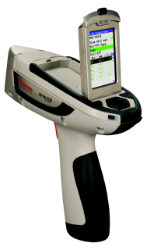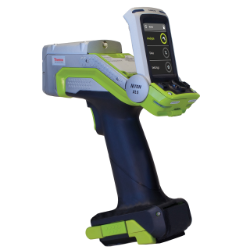An XRF for Tamara
Originally published: January 27, 2017
Folks who follow me or are friends and fans know that an XRF instrument is an integral component of my advocacy work. As a result many have offered to help in some way and want to know how much I need to raise (personally) to buy my own XRF so I can continue doing what I do.
Note: While I am not a hazard assessor and am not affiliated with any kind of lab or testing agency – I am personally trained and certified in using an XRF instrument and have close to 10 years experience doing so. For anyone else interested in either buying or renting an XRF I highly recommend doing the training first. Some states also require the instrument be registered for each use and other states do not (with the non-radioactive source instrument) so look into your state rules before renting an instrument as well. Niton offers the training for free, and it is an 8-hour (full day) training course.
My dream goal:
I would like to get the new Niton XL5 (pictured here) as soon as it is available from ThermoFisher Scientific / Niton with the “Consumer Goods” testing software module (which reads in PPM.) It is my understanding that (as of January 2017) Niton does not yet have the consumer goods testing module available for this instrument.
I will also need the instrument to also have a paint mode, test all mode, soil mode, metals mode and pretty much any other software packages they offer for the unit. It is my understanding that the XL5 (which is a non-radioactive source / x-ray tube based hand held analyzer just like the XL3T (pictured left) outfitted with the software packages that I would like) will cost approximately $55,000 (or I could buy a few houses in Michigan or Iowa! Lol!)
The instrument I have used most frequently (both as a loaner from Niton and purchased for the nonprofit I founded) is an XL3T GOLDD+ (pictured right below) and that would be amazin
When I last coordinated the purchasing of an XL3T GOLDD+ (in March of 2016) I was able to get a demo model direct from Niton for $22,000 – with all of the available software modules installed. This would work well until the “5” is available. I have also used the XL3T 700 / 800 series model (pictured left) which is “good enough” and has similar reading capabilities, but doesn’t have the camera function (and other features) offered in the GOLDD+.
I am looking into the cost and availability of a used XL3T 700 or 800 as well as the availability of a used XL3T GOLDD++/
In the meantime I will do my best to continue renting instruments and do short bursts of consumer goods testing as I can. In January 2017 – 20 friends and followers chipped in to help me cover the costs associated with renting the instrument for a week and I was able to test hundreds of items. Many of these test results were posted on my film’s Facebook page to inform the public and I will also move these testing results and related images over from Facebooks to the blog (under #XRFTesting) as soon as I have time.
I do consumer goods testing primarily to help raise awareness of how much lead (and cadmium, mercury and arsenic too) is in our lives in a daily basis.
I often say that the opportunity to learn about toxicity in consumer goods is a “gateway drug” to get people involved with the issue. Once parents start seeing that there are contaminants in our everyday household items that they own – they eventually come around to looking at their home (or other buildings they spend time in – like their children’s schools) as a potential source of lead exposure to their children as well.
Please keep an eye on my Facebook page and blog for more consumer goods testing parties as they come up.
If you would like to make a gift to help me get a new instrument please click the link below.
I started a GoFundMe to help me get an XRF!
Thank you for reading!
Sincerely,
Tamara Elise Rubin
#LeadSafeMama









